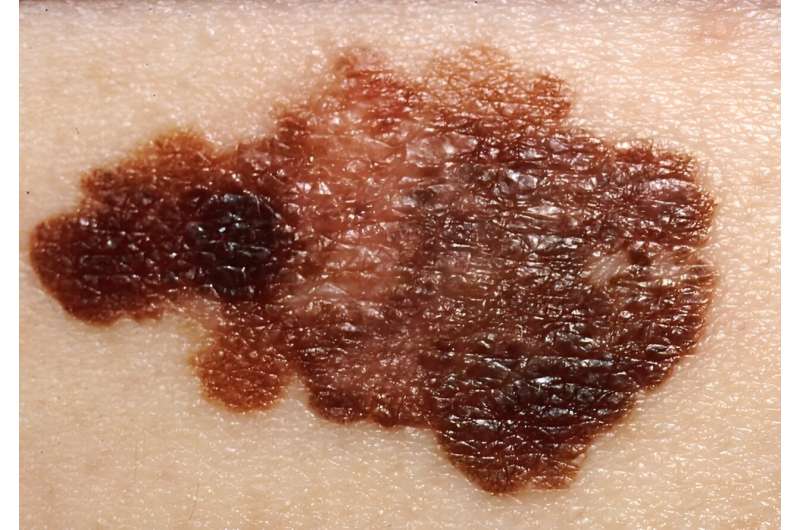This article has been reviewed according to Science X's editorial process and policies. Editors have highlighted the following attributes while ensuring the content's credibility:
fact-checked
trusted source
written by researcher(s)
proofread
Sarah Ferguson diagnosed with malignant melanoma. Here are the latest treatments

News that Sarah Ferguson, the Duchess of York, has recently been diagnosed with malignant melanoma highlights the dangers of this increasingly common skin cancer.
Malignant melanoma affects 325,000 people worldwide every year. While it's not the most common form of skin cancer—typically, for every one diagnosed case of melanoma, up to ten non-melanoma skin cancers are diagnosed—it causes almost as many deaths. The reason for this is because it's far more likely to spread, or metastasize, to other sites in the body compared to non-melanoma skin cancers.
Melanoma arises in a type of pigment-producing skin cell called a melanocyte. These cells produce and export melanin in order to provide a protective layer in the skin which helps to screen out ultraviolet (UV) radiation.
Mutations in genes that normally carefully regulate cell growth and survival override the controls that ensure the body only produces the cells it needs. The result is uncontrolled cellular growth, or a tumor, that normally appears as an unusual-looking mole.
The mutations that drive the growth of a melanoma usually happen as a result of exposure to UV from the sun or from an artificial source, such as a tanning bed. We know this because when a melanoma's genome is compared to that of a normal cell we can see a high number of mutations that have a characteristic "UV signature." For this reason, melanoma skin cancers occur most frequently in people who have light-colored skin and who are exposed to high amounts of UV.
Non-melanoma skin cancers are also mainly caused by exposure to UV but arise from a different kind of skin cell called a keratinocyte. These are the cells that normally make up the majority of the outer part of our skin, called the epidermis. Cancers that arise from keratinocytes are less likely to spread than those that come from melanocytes—although they can still be fatal.
In the duchess's case, the melanoma was discovered during treatment for breast cancer. Her dermatologist recommended that some moles be removed for biopsy during breast reconstruction surgery. After testing, one was identified as malignant melanoma.
If the results of the biopsy show that the cancer hasn't spread, then like the majority of patients with melanoma, the duchess will be treated with surgery. In this case the tumor will be removed along with some of the surrounding normal skin.
The amount of normal skin removed depends on the results of the biopsy—in particular, how deep into the skin the tumor has penetrated (called the Breslow thickness). The normal skin will be checked for any signs that cancerous cells might have spread out of the tumor.
For most people diagnosed with melanoma, particularly if it's at an early stage, surgery will cure the cancer and they will be able to go on with their lives. But for around 20% of patients, additional treatment will be needed. This happens if their cancer has spread further into the body or if their cancer can't be treated surgically. The good news for these patients is that the past decade has seen huge improvements in treatment.
Previously the only options other than surgery were radiotherapy or non-specific chemotherapy treatments. These treatments work by affecting the ability of cells to copy their DNA, which prevents them from duplicating and causes fast-growing cancer cells to die. But because these also affect the patient's normal cells, they were accompanied by severe side effects—and were often ineffective.
But we now have a better understanding of the specific changes melanoma makes to cell growth pathways. This has led to the development of drugs, such as dabrafenib and trametinib, that specifically target cells with these altered pathways. In other words, they only target the cancerous cells.
These drugs are much more effective and have fewer side effects than traditional chemotherapies—although about half of patients who initially respond to them relapse within a year. In these patients a few of the tumor cells survive by activating other pathways for growth and use these to regrow the tumor. Promisingly, a recent study suggests that re-using these drugs after a period off them can have good results in relapsed patients.
Another exciting development in the treatment of malignant melanoma has been the use of immunotherapies. These involve harnessing the patient's own immune system to fight the tumor.
One particularly successful immunotherapy approach for melanoma involves the use of drugs called checkpoint inhibitors. These prevent cancer cells from being able to hide from the body's immune system. A recent report has highlighted how the introduction of these treatments has led to improved survival for melanoma patients.
Although the duchess's skin cancer was discovered while she was being treated for breast cancer, it's unlikely that the two are related. A more likely risk factor is the duchess's famous red hair. People with red hair and pale skin that tends to freckle and burn in the sun are at a greater risk of developing skin cancer because their skin produces less melanin. This means that their melanocytes are exposed to higher levels of UV and are more likely to undergo cancer-causing mutations.
While melanoma is much more common in people with the duchess's skin type, it's important to be aware that anyone can get it. It's a good idea to regularly check your skin for unusual looking moles and to contact a doctor for advice if you have a mole with any of the so-called ABCDE characteristics: such as an asymmetrical shape, irregular, blurred or jagged border, uneven color, is more than 6mm wide and is evolving (either in size, texture or even bleeding).
This article is republished from The Conversation under a Creative Commons license. Read the original article.![]()



















